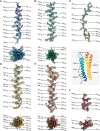2.7 Å cryo-EM structure of vitrified M. musculus H-chain apoferritin from a compact 200 keV cryo-microscope
- PMID: 32374767
- PMCID: PMC7202636
- DOI: 10.1371/journal.pone.0232540
2.7 Å cryo-EM structure of vitrified M. musculus H-chain apoferritin from a compact 200 keV cryo-microscope
Abstract
Here we present the structure of mouse H-chain apoferritin at 2.7 Å (FSC = 0.143) solved by single particle cryogenic electron microscopy (cryo-EM) using a 200 kV device, the Thermo Fisher Glacios®. This is a compact, two-lens illumination system with a constant power objective lens, without any energy filters or aberration correctors, often thought of as a "screening cryo-microscope". Coulomb potential maps reveal clear densities for main chain carbonyl oxygens, residue side chains (including alternative conformations) and bound solvent molecules. We used a quasi-crystallographic reciprocal space approach to fit model coordinates to the experimental cryo-EM map. We argue that the advantages offered by (a) the high electronic and mechanical stability of the microscope, (b) the high emission stability and low beam energy spread of the high brightness Field Emission Gun (X-FEG), (c) direct electron detection technology and (d) particle-based Contrast Transfer Function (CTF) refinement have contributed to achieving high resolution. Overall, we show that basic electron optical settings for automated cryo-electron microscopy imaging can be used to determine structures approaching atomic resolution.
Conflict of interest statement
The authors have declared that no competing interests exist.
Figures





Similar articles
-
Single-particle cryo-EM at atomic resolution.Nature. 2020 Nov;587(7832):152-156. doi: 10.1038/s41586-020-2829-0. Epub 2020 Oct 21. Nature. 2020. PMID: 33087931 Free PMC article.
-
A new cryo-EM system for single particle analysis.J Struct Biol. 2019 Jul 1;207(1):40-48. doi: 10.1016/j.jsb.2019.04.011. Epub 2019 Apr 13. J Struct Biol. 2019. PMID: 30991102
-
High-resolution single-particle imaging at 100-200 keV with the Gatan Alpine direct electron detector.J Struct Biol. 2024 Sep;216(3):108108. doi: 10.1016/j.jsb.2024.108108. Epub 2024 Jun 27. J Struct Biol. 2024. PMID: 38944401 Free PMC article.
-
Refinement of Atomic Structures Against cryo-EM Maps.Methods Enzymol. 2016;579:277-305. doi: 10.1016/bs.mie.2016.05.033. Epub 2016 Jun 24. Methods Enzymol. 2016. PMID: 27572731 Review.
-
Frealign: An Exploratory Tool for Single-Particle Cryo-EM.Methods Enzymol. 2016;579:191-226. doi: 10.1016/bs.mie.2016.04.013. Epub 2016 Jun 7. Methods Enzymol. 2016. PMID: 27572728 Free PMC article. Review.
Cited by
-
High-speed high-resolution data collection on a 200 keV cryo-TEM.IUCrJ. 2022 Jan 29;9(Pt 2):243-252. doi: 10.1107/S2052252522000069. eCollection 2022 Mar 1. IUCrJ. 2022. PMID: 35371504 Free PMC article.
-
Present and Emerging Methodologies in Cryo-EM Single-Particle Analysis.Biophys J. 2020 Oct 6;119(7):1281-1289. doi: 10.1016/j.bpj.2020.08.027. Epub 2020 Sep 1. Biophys J. 2020. PMID: 32919493 Free PMC article. Review.
-
Cryo-EM of a heterogeneous biochemical fraction elucidates multiple protein complexes from a multicellular thermophilic eukaryote.J Struct Biol X. 2023 Aug 9;8:100094. doi: 10.1016/j.yjsbx.2023.100094. eCollection 2023 Dec. J Struct Biol X. 2023. PMID: 37638207 Free PMC article.
-
Insights into the bilayer-mediated toppling mechanism of a folate-specific ECF transporter by cryo-EM.Proc Natl Acad Sci U S A. 2021 Aug 24;118(34):e2105014118. doi: 10.1073/pnas.2105014118. Proc Natl Acad Sci U S A. 2021. PMID: 34408021 Free PMC article.
-
Sub-3 Å resolution protein structure determination by single-particle cryo-EM at 100 keV.Structure. 2025 Jul 26:S0969-2126(25)00255-2. doi: 10.1016/j.str.2025.07.007. Online ahead of print. Structure. 2025. PMID: 40744008
References
Publication types
MeSH terms
Substances
LinkOut - more resources
Full Text Sources

